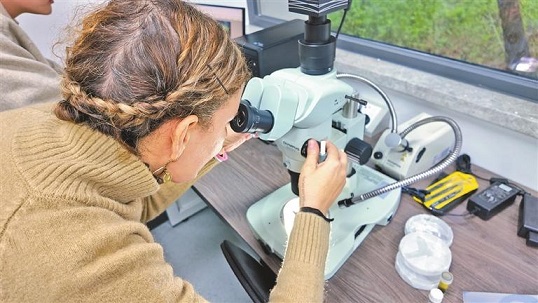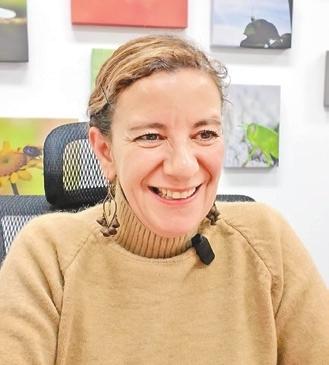Shenzhen
 2024/12/13
2024/12/13
 source: Shenzhen Daily
source: Shenzhen Daily
 Print
Print

Ana Gouveia observes a mayfly specimen under the microscope in her lab. Photos by Chen Siqi

Ana Gouveia
Chen Siqi
vankochensq@163.com
UPON entering Ana Gouveia’s urban ecology lab, visitors are greeted by a series of nature photographs adorning the walls. Gouveia — a nature enthusiast, assistant professor, and leader of the urban ecology lab at Tsinghua Shenzhen International Graduate School — has over 10 years of research experience in several countries, including the Czech Republic, the U.S., and the U.K.
From 2016 to 2019, the Portuguese spent four years at the Xishuangbanna Tropical Botanical Garden under the Chinese Academy of Sciences. Now based in Shenzhen, Gouveia described the opportunity to establish her lab as a dream come true for any researcher.
A passion for ecology
Gouveia attributes her love of nature to her father, a fellow nature lover who enjoyed gardening. “I grew up surrounded by nature, and we had a very large garden,” she recalled.
Sharing an anecdote about her childhood fascination with small insects, she said, “Every time I returned home, my mother would say, ‘Show me your pocket. What’s inside?’” Gouveia would pull little insects out, chuckling. “I was always curious about animals and wanted to learn more about them.”
Her love of nature inspired her to pursue a career in ecological research. Encouraged by a professor who shared her passion for nature, ecology, biology, and zoology during her bachelor’s studies, she shifted her focus from biology in her undergraduate and master’s programs to specialize in ecology during her Ph.D., ultimately becoming a professor in the field.
As a researcher, Gouveia believes that passion is essential. “Sometimes research can be tedious. Data collection may not always yield expected results, and setbacks are common. Without love and passion, you can’t work effectively,” she noted. “First, we need to help people understand the importance of studying ecology. Then, we must inspire them to fall in love with it.”
Founding a lab
Gouveia’s journey in Shenzhen began in February 2023 when she accepted an offer from Tsinghua Shenzhen International Graduate School that would allow her to establish an urban ecology lab. “The job offer was incredibly appealing. The opportunity to build a lab from scratch is rare in academia,” Gouveia said.
In just six months, she transformed a modestly sized, empty room into a fully equipped lab, complete with cabinets, microscopes, drones, and various detectors. The lab also houses butterflies and other insect species, which are central to its research focus.
Gouveia’s lab now consists of nine members, including one postdoctoral researcher, four master’s students, three Ph.D. candidates, and Gouveia herself. “I’m very proud of my group,” she said. “I’m looking forward to seeing their outcomes as we’re still in the early stages.”
Gouveia mentioned that Shenzhen is a “perfect place for urban ecological research.” She explained, “Shenzhen is like a gigantic lab. We have mangroves, oceans, rivers, and mountains — every natural element is present here. Despite ongoing urbanization, Shenzhen does a good job of preserving biodiversity.”
Biodiversity in Shenzhen
Gouveia has explored many green spaces in Shenzhen, and Dapeng has become her favorite. According to Gouveia, the area is rich in greenery and exemplifies Shenzhen’s commitment to sustainable development. “Dapeng is a great example of how to balance urban growth with a focus on protecting biodiversity,” she said.
Explaining the difference between ecology and urban ecology, with the latter being her specific research area, Gouveia said, “Ecology studies the connections between animals and humans within our environment and how we can coexist harmoniously. However, urban ecology research aims to make cities and urban spaces friendly to both humans and biodiversity.”
Shenzhen, despite being a highly urbanized city, has made significant efforts to preserve its natural environment. “Shenzhen is a highly urbanized area with 20 million residents, yet we still have natural and biodiversity-rich areas that are crucial for our well-being,” she noted.
As part of these efforts, the city is striving to become a “city of parks.” It currently boasts over 1,200 parks and plans to expand that number to more than 1,500 by 2035.
Gouveia emphasized that it’s not enough to simply build gardens and green spaces — it’s essential to assess their effectiveness in preserving biodiversity. “It is important to have that garden, and — more important —we have to assess whether these green spaces are actually effective,” she said. “One of the most important reasons for building these gardens or green infrastructure in urban ecology is to maintain biodiversity.”
To drive the point home, she explained that a garden with only one species of plant would not be sufficient to attract butterflies. “Butterfly diversity increases with plant diversity because they feed on different plants and lay their eggs on various plant species,” said Gouveia.
Therefore, she recommends that the creation of green spaces should not only focus on their existence, but also on understanding their purpose and ensuring they are effective for both biodiversity and human well-being.





